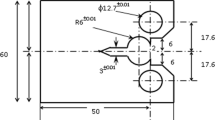This article examines another two of the six most typical types of fracture of steel and steel structures: fracture under a cyclic load (fatigue) and hydrogen-induced delayed brittle fracture. It also examines the associated micro-mechanisms that result in the formation of a characteristic relief on the fracture surface.










Similar content being viewed by others
References
S. V. Serensen,V. P. Kogaev, and R. M. Shneiderovich, Load-Carrying Capacity and the Strength Design of Machine Parts [in Russian], Mashinostroenie, Moscow (1975).
V. V. Evdokimov, Low-Cycle Strength of Welds of Metal Structural Elements in Connection with the Nonuniformity of the Stress-Strain State in Regions with Butt Welds and Fillet Welds: Author’s Abstract of Engineering Sciences Candidate Dissertation, Moscow (1981).
L. I. Gladshtein, N. I. Kelberin, V. I. Meitin, and R. A. Milievskii, “Fatigue fracture of high-strength bolts in steel structures,” PGS, No. 12, 24–27 (2007).
G. V. Karpenko and R. I. Kripyakevich, Effect of Hydrogen on the Properties of Steel [in Russian], Metallurgizdat, Moscow (1962).
B. A. Kolachev, Hydrogen Embrittlement of Metals [in Russian], Metallurgiya, Moscow (1985).
A. R. Troiano, Trans. ASM, 52, 54–80 (1960).
K. Mac-Magon, K. Bryant, and S. Enerdgie, “Effect of hydrogen and impurities on the brittle fracture of steel,” in: Mechanics: Advances in Foreign Science, Iss. 17, Fracture Mechanics, Fracture of Materials [Russian translation], Mir, Moscow (1979), pp. 109–133.
L. I. Gladshtein and G. A. Filippov, “Bolts with a strength of 1400–1600 N/mm2 and good resistance to delayed brittle fracture,” Stal, No. 7, 74–83 (2009).
Author information
Authors and Affiliations
Corresponding author
Additional information
End of an article begun on pages 123–130 in Issue No. 2 of Metallurgist for 2011 and continued on pp. 177–186 in Issue No. 3 of Metallurgist for 2011.
Translated from Metallurg, No. 4, pp. 70–77, April, 2011.
Rights and permissions
About this article
Cite this article
Gladshtein, L.I. Fracture of the materials and elements of steel structures. Metallurgist 55, 278 (2011). https://doi.org/10.1007/s11015-011-9425-3
Received:
Published:
DOI: https://doi.org/10.1007/s11015-011-9425-3




